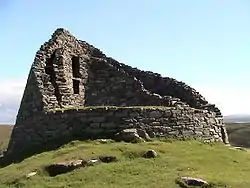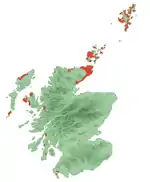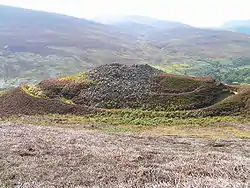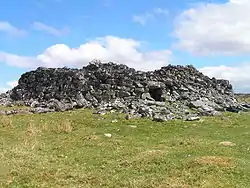Брох
Брох — тип круглої фортечної споруди періоду залізної доби, викладеної методом сухої кладки (тобто без використання скріплювального розчину). Брохи характерні тільки для Шотландії, де їх існує понад 100[1]. Слово broch походить з давньонорвезької мови й означає «фортеця» (в англійській мові існують топоніми з тим же коренем, у таких формах brough, borough, borve).[2]




Деякі брохи дуже складні з архітектурної точки зору і належать до типу «комплексних атлантичних круглих будинків» за класифікацією шотландських археологів, запропонованою в 1980-і роки. Призначення брохів та їх культурна приналежність є предметом суперечок. До 1960-х рр. ні в кого не викликало сумніву, що брохи створили кельти — предки шотландців, які мігрували з материка[3][4]. Потім, через наявність археологічних знахідок, що вступали в суперечність з даною теорією, все більше археологів схиляються до версії про їх піктське або змішане походження[5][6] (при цьому не підлягає сумніву, що брохи могли використовуватися і в післяпіктський період).
Найбільш ранні брохи з'явилися близько I століття до н. е.[7][8]
Висота брохів невідома, стіни, що збереглися, мають висоту не більше як 10 метрів. Брохи, напевно, мали дахи, які не збереглися до наших днів. Внутрішній діаметр становив від 5 до 15 метрів. Деякі були оточені невеликими житловими будинками.
Див. також
- Дун (фортеця)
- Колесоподібний будинок
- Нурагі
Примітки
- Armit (2003) p. 16.
- Armit (2003) p. 13.
- Scott, Sir Lindsay (1947), 'The problem of the brochs', Proceedings of the Prehistoric Society 13, pages 1-36.
- Childe, V. G. (1935) The Prehistory of Scotland. London.
- Parker Pearson, M. & Sharples, N. Et al(1999)Between land and sea: excavations at Dun Vulan, South Uist. Sheffield.
- MacKie, E. W. (1965) 'The origin and development of the broch and wheelhouse building cultures of the Scottish Iron Age'. Proceedings of the Prehistoric Society 31, pages 93-146.
- MacKie, E. W. (2007) The Roundhouses, Brochs and Wheelhouses of Atlantic Scotland c. 700 BC — AD 500: architecture and material culture. Part 2 The Mainland and the Western Islands. British Archaeological Reports British Series (forthcoming). Oxford.
- For the C14 dates for the Shetland sites see Shetland Amenity Trust Архівовано 4 травня 2009 у Wayback Machine. Retrieved 14 August 2007.
Література
- Armit, I. (1991) The Atlantic Scottish Iron Age: five levels of chronology, Proc. Soc. Antiq. Scot. v. 121, p. 181—214, ISSN 0081-1564
- Armit, I. (1996) The Archaeology of Skye and the Western Isles, Edinburgh University Press, ISBN 0-7486-0640-8
- Armit, I. (2003) Towers in the North: The Brochs of Scotland, Stroud: Tempus, ISBN 0-7524-1932-3
- Ballin Smith, B. and Banks, I. (eds) (2002) In the Shadow of the Brochs, the Iron Age in Scotland, Stroud: Tempus, ISBN 0-7524-2517-X
- Fojut, N. (1982) Towards a Geography of Shetland Brochs, Glasgow Archaeological Journal, v. 9, p. 38-59, ISSN 0305-8980
- Harding, D.W. (2000) The Hebridean Iron Age: Twenty Years’ Research, University of Edinburgh Department of Archaeology, Occasional Paper No. 20, ISSN 0144-3313
- Harding, D.W. (2004) The Iron Age in Northern Britain, London: Routledge, ISBN 0-415-30150-5
- Hingley, R (1992) Society in Scotland from 700 BC to 200 AD, Proc. Soc. Antiq. Scot. v. 122, p. 7-53, ISSN 0081-1564.
- MacKie, E W 1992 The Iron Age semibrochs of Atlantic Scotland: a case study in the problems of deductive reasoning. Archaeol Journ 149 (1991), 149-81.
- MacKie, E W 1995a Gurness and Midhowe brochs in Orkney: some problems of misinterpretation. Archaeol Journ 151 (1994), 98-157.
- MacKie, E W 1995b The early Celts in Scotland. Miranda Green (ed) The Celtic World. Routledge, London: 654-70.
- MacKie, E W 1997 Dun Mor Vaul re-visited, J.N.G. Ritchie (ed) The Archaeology of Argyll. Edinburgh: 141-80.
- MacKie, E W 1998 Continuity over three thousand years of northern prehistory: the ‘tel’ at Howe, Orkney. Antiq Journ 78, 1-42.
- MacKie, E W 2000 The Scottish Atlantic Iron Age: indigenous and isolated or part of a wider European world? 99-116 in Jon C Henderson (ed) The Prehistory and Early History of Atlantic Europe. BAR International Series 861: Oxford.
- MacKie, E W 2002a Excavations at Dun Ardtreck, Skye, in 1964 and 1965. Proc Soc Antiq Scot 131 (2000), 301—411.
- MacKie, E W 2002b The Roundhouses, Brochs and Wheelhouses of Atlantic Scotland c. 700 BC — AD 500: architecture and material culture. Part 1 The Orkney and Shetland Isles. British Archaeological Reports British Series 342. Oxford.
- MacKie, E. W. 2005 119. Scottish brochs at the start of the new millennium, 11-31 in Turner, Val E, Nicholson, Rebecca A, Dockrill, S J & Bond, Julie M (eds.) Tall stories? Two millennia of brochs. Lerwick.